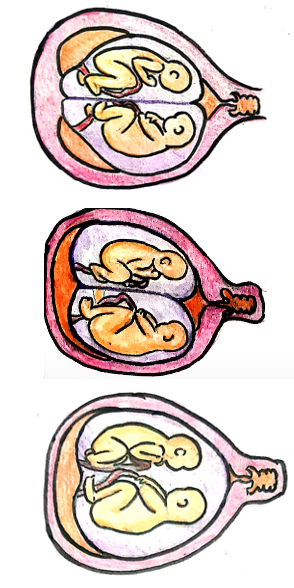Back to: Obstetrics
Twins
The probability of having twins is just under 1% which means that it is not very uncommon.
– There are two main types of twins, according to whether one or two egg cells has been fertilised.
Monozygotic (MZ) twins
This describes twins which develop from a single ovum which then divides into 2 identical embryos
– In monozygotic pregnancies, there are various ways in which the amniotic sac and placenta are shared.
i) Dichorionic, diamniotic (DCDA)
Each twin has its own individual amniotic sac and placenta
– About 1/3 of monozygotic pregnancies
ii) Monochorionic, diamniotic (MCDA):
These twins share a placenta but have individual amniotic sacs
– This accounts for about 2/3 of monozygotic pregnancies
iii) Monochorionic, monoamniotic (MCDA):
The twins share both the placenta and amniotic sac
– These are the rarest type of monozygotic pregnancies

Twin-Twin Transfusion Syndrome
One of the biggest complications of sharing a placenta is Twin-twin transfusion syndrome:
– As a result of sharing one placenta, the blood supply can become connected between foetuses
– This allows blood to pass from one twin to the other
– Blood may be transferred disproportionately from one twin (the donor) to the other (the recipient)
– For the donor, reduced blood volume gives retarded growth and oligohydramnios
– For the recipient –> excess blood gives tissue swelling, strain on heart (heart failure) and polyhydramnios
Diagnosis
– Ultrasound shows polyhydramnios around one twin and oligohydramnios around other
Management
– Fetoscopic laser ablation of the interconnecting vessels
Dizygotic (DZ) twins
This describes twins that develop from two separate eggs cells fertilised by two different spermatozoa
– The twins are genetically different from each other and share the same gene proportions as normal siblings
– All dizygotic pregnancies are dichorionic, diamniotic
– Due to the risk of placental failure, most twins will be delivered earlier than 40 weeks (around 38 weeks)
Risk factors:
– Family history of multiple pregnancies, also higher in certain races
– Increased maternal age
– IVF
Complications:
– In utero –>Twin-twin transfusion (if MZ twins), Prematurity, small for gestational age
– Delivery –> Higher risk of malpresentation, cord prolapse and post-partum haemorrhage
– Mother –> Anaemia, pre-eclampsia
Management:
Mothers require more supplements (iron and folate) and increased monitoring antenatally
– Apart from that, most cases progress like single pregnancies if there are no complications



